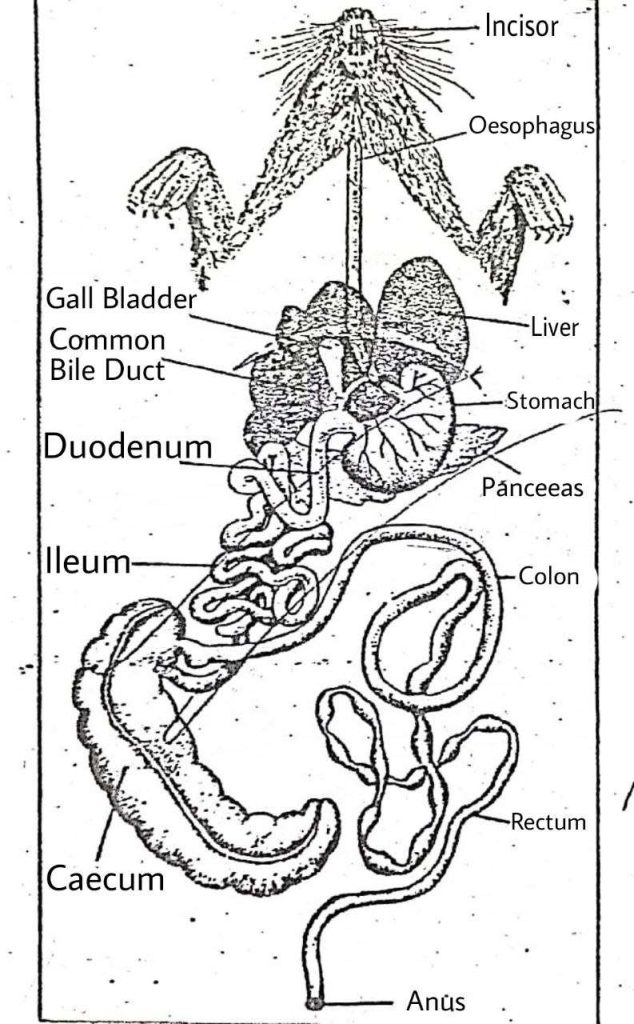In this article on Cavia porcellus or Guinea pig, we will learn about the digestive system of the guinea pig or Cavia porcellus in an extended way.
Digestive System of the Guinea Pig
Digestion is a physiological system by which the complex food turns into simple food to absorb nutrients to keep the body functioning and healthy. The digestive system is a system of organs by which digestion occurs. The digestive system of the guinea pig is divided into two parts. They are:
- Digestive Tract / Alimentary Canal, and
- Digestive Glands.

fig: Digestive system of the Guinea pig (Cavia porcellus)
1. Alimentary Canal
- It is a long tube.
- It starts from the mouth and ends at the anus.
- The alimentary canal is demarked into different regions and the function of each region is different.
The description of the different regions is given below-
A. Mouth
- The alimentary canal starts from the mouth.
- It is a transverse aperture at the anterior end of the body.
- It is guarded by two soft lips.
- Lips are movable.
- The upper lip has a cleft in the middle.
- The upper incisors protrude with the cleft.
B. Buccal Cavity
- The mouth opens into the buccal cavity.
- The roof of the buccal cavity is formed by a palate.
- The anterior portion of the palate is the hard palate and the posterior portion of the palate is the soft palate.
- The anterior portion of the palate is supported by bones and that’s why it is hard.
- The posterior portion of the palate has no bony support and that’s why it is soft.
- The palate separates the mouth cavity and the nasal passage.
- A tongue is present on the floor of the buccal cavity. Anteriorly the tongue is free and posteriorly it is attached to the floor of the buccal cavity.
- The tongue is muscular, movable, and has taste buds on its upper surface.
- Both jaws have teeth and the teeth help in ingesting food.
- The teeth are thecodont, heterodont, and diphyodont types.
- Each tooth has two parts. The crown and the root.
- The visible part of the teeth is the crown and the part which is embedded in the socket is called the root.
- The tooth is made up of dentine and the dentine of the root region is covered with enamel.
The Incisors
- The incisors are sharp and chisel-like teeth.
- They are used to cut up the food into small pieces.
- A total of four incisors are present. Two at the upper jaw and two at the lower jaw.
- These teeth are located in the front and center of the mouth.
- The incisor teeth of the guinea pig grow continuously and that’s why they must be worn down all the time.
- The teeth ideally grate each other when Cavia bites off.
The Molars
- There is one premolar and then three molars on each side, both on the top and the bottom.
- Molar teeth also grow continuously.
- The Cavia used these teeth to mix the food with the saliva and to soften the food. These teeth crush and grind the food.
C. Pharynx
- The buccal cavity leads into the pharynx.
- The pharynx is divided into two parts. The dorsal part of the pharynx is the naso-pharynx and the ventral part of the pharynx is the bucco-pharynx.
- The internal nostrils and the eustachian tubes enter into the naso-pharynx region.
- A slit is present just posterior to the tongue and floor of the bucco-pharynx called the glottis.
- The glottis communicates with the respiratory tube. It is guarded by the cartilaginous epiglottis.
- Bucco-pharynx opens into the oesophagus through an aperture called the gullet.
D. Oesophagus
- The pharynx opens into the oesophagus.
- It is a long tube.
- It runs through the thoracic region and passes the diaphragm.
- It is an organ for the transportation of chewed food to the stomach.
E. Stomach
- The oesophagus opens into the stomach.
- It is a highly muscular and glandular sac.
- The inner concave side of the stomach is called lesser curvature.
- The outer convex side of the stomach is called greater curvature.
- The stomach is divided into two parts. The anterior part of the stomach is the cardiac stomach and the posterior part of the stomach is the pyloric stomach.
- The opening of the stomach into the intestine is guarded by a sphincter named the pyloric sphincter.
- In the stomach, the digestion process begins.
F. Intestine
- The stomach opens into the intestine.
- The main part of the digestion process occurs here.
- Also, nutrient and water absorption occur here.
- The whole intestine is divided into the duodenum, ileum and large intestine.
Duodenum
- The anterior portion of the intestine is called the duodenum.
- It forms a “U” shape with the stomach.
- The common bile duct opens into the duodenum.
Ileum
- The middle part of the intestine is the ileum.
- It is a much longer and coiled tube.
- It opens into the large intestine and is guarded by an ileocolic valve before opening.
Large Intestine
- The posterior portion of the intestine is the large intestine.
- It is further divided into two parts; the colon and the rectum.
- The anterior large intestine is known as the colon and the posterior large intestine is known as the rectum.
- A large sac, named caecum is present at the opening point of the ileum into the colon.
- Re-absorption occurs in the large intestine.
- The rectum is used as the storage of faecal matter.
G. Anus
- The alimentary canal or digestive tract ends here.
- It is an aperture by which the Cavia expels out the faecal matter to the outside.
- It is guarded by a sphincter muscle.
2. Digestive Glands
Several digestive glands help to complete the process of digestion and they are described below-
A. Salivary Gland
- There are five pairs of salivary glands present in guinea pigs.
- The name of the five pairs of salivary glands is parotid glands, mandibular glands, major sublingual glands, minor sublingual glands, and zygomatic or infra-orbital glands.
- All the glands open into the buccal cavity through separate ducts.
- Salivary glands secret saliva which contains the enzyme ptyalin.
B. Liver
- It is located beneath the diaphragm and above the stomach.
- The liver is divided into four lobes.
- The secretion of the liver is bile.
- Bile is stored in the gall bladder which is lodged in the quadrate lobe of the liver.
- The common bile duct carries bile to the duodenum.
C. Pancreas
- It is located between the limbs of the duodenum.
- The secretion of the pancreas is known as pancreatic juice.
- The pancreatic juice is carried to the duodenum by the pancreatic duct.
D. Gastric Glands
- The gastric glands are present in the inner lining of the stomach.
- The secretion of the gastric glands is known as gastric juice.
E. Intestinal Glands
- In the inner lining of the intestine, especially the duodenum, numerous intestinal glands are present.
3. Mechanism of Digestion
- The digestion mechanism of Cavia is divided into three steps and the steps are ingestion, digestion, and egestion.
A. Ingestion
- Young guinea pigs feed on the milk.
- Adults are herbivorous and they feed on vegetarians.
B. Digestion
- The digestion starts in the buccal cavity.
- The enzymes of saliva break down starch into maltase.
- The gastric juice has HCl acid and some enzymes. Partial digestion occurs in the stomach.
- The partially digested food slowly enters the duodenum.
- In the duodenum, the food comes in contact with bile and pancreatic juice.
- The full digestion of food occurs in the intestine.
- The absorption also occurs inside the intestine.
C. Egestion
- After the absorption of water and nutrients, the undigested residual matter is kept in the rectum temporarily.
- Cavia then expels out the faecal matter through the anus.
- The faecal matters that pass during the daytime are dry and hard.
- The faecal matters that pass during the night are soft with mucous.
- The Guinea pig has a habit of taking the soft nocturnal faecal matters again and that’s why they are called coprophagous.
———————THE END———————
Read More:
- External Morphology of Guinea Pig | Cavia porcellus | Diagram
- Nervous System of Guinea Pig | Cavia porcellus | Diagram
- Circulatory System of Guinea pig | Cavia porcellus | Diagram
- Respiratory System of Guinea Pig | Cavia porcellus | Diagram
- General Characters of All Classes of Vertebrates.
References:

Md Ekram Hossain Bhuiyan is a passionate student currently pursuing his studies at Jagannath University in Dhaka. He is a zoology major and his love for animals, nature, and wildlife is evident in his academic pursuits. Ekram is a curious and adventurous individual who always seeks to learn more about the world around him. His passion for animals began at a young age, and he has since dedicated himself to studying the behavior, anatomy, and habitats of various species.
He finds peace in being surrounded by the beauty of nature and observing the creatures that call it home. He believes that it is important to protect and preserve the natural world for future generations.
As a student of zoology, Ekram is dedicated to expanding his knowledge of the subject. He is a hardworking individual who strives for excellence in his studies and is always eager to take on new challenges. Ekram is a driven and compassionate individual who is dedicated to his studies and his passion for animals, nature, and wildlife.